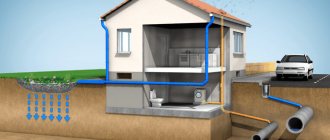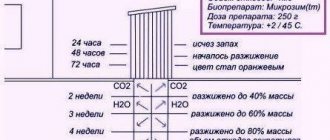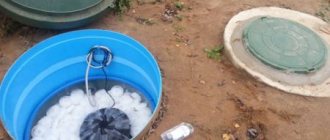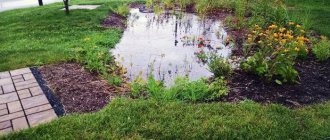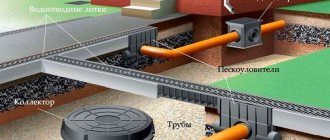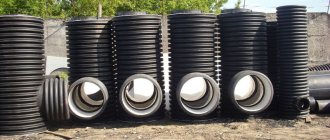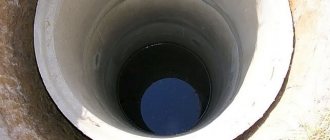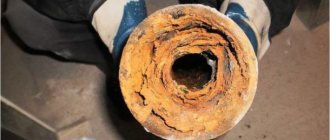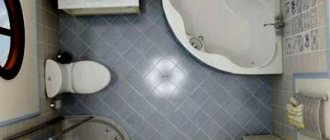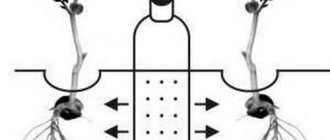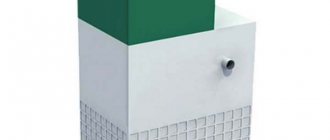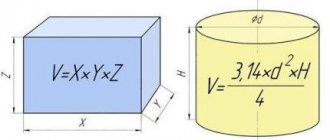What it is?
These are complex measures for collecting surface water. This means the manufacture of bends from special pipes, gutters, siphons, sand traps, plugs, storm water inlets and other elements. Its main task is to collect and drain rainwater, melted snow and similar precipitation from the house. Discharge can be carried out into a septic tank or a special container.
Advice! If a ground drainage system is being constructed on a site, then stormwater runoff cannot be directed to one place. As a rule, drainage and stormwater are laid in one trench in parallel, but water is collected in different places. Moreover, the stormwater system is located higher in level.
Varieties
There are several types of stormwater systems. According to the method of waste collection:
- point. Liquid intake is carried out through special storm water inlets located under the vertical sections of the drainage system of buildings;
- linear. They are a system of extended open gutters located on the lines of lowering the relief of the site. Used to collect and drain excess water from the territory.
By type of element placement:
- open (external). They are gutters through which wastewater coming from the surface moves;
- closed (underground, deep). This is a pipeline system that performs the functions of transferring wastewater to treatment plants;
- mixed. Systems that consist of open and closed elements.
Most often mixed types are used. An open storm drain is convenient because any blockages or blockages can be removed quickly and without much difficulty. However, it is extremely difficult to use the area through which the network of open elements passes. Hidden pipes allow the area to be used for various household purposes, but any blockage or blockage becomes a serious problem. Storm drainage is a network that is constantly at risk of clogging. Drains carry large amounts of dust, sand and small debris. Cleaning underground pipes creates considerable difficulties. Therefore, the system is combined using open and closed elements where possible.
In addition, there are gravity and pressure types of storm sewers. In the first, the movement of wastewater occurs independently, due to the slope of the pipes. The latter are rarely used, only in areas with complex terrain or in densely built-up areas.
Stormwater systems of industrial enterprises are considered a separate type. Industrial storm sewers perform the same tasks, but differ in their large size, complex configuration and composition of liquids. The construction of industrial and stormwater complexes is a separate system, equipped with its own treatment facilities and a network of transport pipelines.
Also read:
Drainage and storm sewerage - types and features of systems
Plumbing pipes and PVC adapters for sewerage, sizes and types
Nuances when installing on the site with your own hands
Must be manufactured in accordance with all prescribed requirements:
- Features of the landscape (slope, location of buildings on the territory, presence of reservoirs, etc.).
- Geological features (nature of the soil, its ability to absorb, etc.).
- The specifics of the building on which the external part of the rainwater drainage system will be installed.
- What is the average rainfall in your area?
- Where and how other utilities are located.
- What will be the total collection and drainage area?
SNiP
Mandatory compliance with SNiP and similar standards according to GOST for its manufacture in a small area. Failure to comply with basic requirements will lead to malfunctions in its operation. Thus, the main provisions are set out in SNiP 2.04.03-85 “Sewerage. External networks and structures.”
To achieve the greatest effect, it is extremely important to have the following information at hand, preferably documented:
- Plan of the existing sewer system.
- Working drawings.
- A network profile is made in a longitudinal section.
- A statement of the work that will be carried out.
Types of rain systems and their design
There are three main types and methods of organizing a drainage system for collecting rainwater:
- Open.
- Closed.
- Mixed.
The first option is the simplest and most inexpensive way to arrange a storm drain. This refers to a system of installed gutters on the roof. Water is collected through them. Then the drainage is carried out through semi-open special grooves.
Purpose, features of the system
Storm sewer (or simply storm drain) is a system for draining rain or melt water. It is a complex of drainage trays or pipelines through which wastewater is directed to the discharge point. The fundamental difference from domestic or industrial systems is the absence of drain holes and the need to organize water collection. In addition, the frequency of operation of the storm drain depends on weather conditions. During the warm season, the system can be idle for months. With the onset of cold weather, the work of storm sewers stops.
Installing a storm drain is a reliable way to protect the site and foundation of a house from erosion. Proper laying of drainage channels eliminates the formation of puddles in the yard and ensures organized collection, purification and removal of excess water. Reservoirs, ravines, or soil infiltration techniques are used as discharge points.
Selecting material for the system
Rainwater collection is carried out using:
- pipes;
- wells;
- receiving elements;
- gutters.
When choosing them, it is necessary to take into account some features. An important component of the system are the receiving elements. Funnels are installed on the roof and platforms. They are made from polymer concrete, polypropylene and polyethylene. Their design includes filter baskets in which various inclusions settle. To prevent the release of unpleasant odors from them, some types of receivers have siphons. Their installation is carried out under pipes when organizing a point system.
At the entrance to the building, door trays can be installed, which include a drainage outlet and a protective mesh on top. Plus, this grill allows you to remove dirt from shoes.
Mandatory elements are pipelines, gutters and trays. The most commonly used are polymer pipes and PVC. One important requirement is that all pipe joints must be sealed.
Trays for transporting sediments are made of ordinary concrete or polymer materials. The latter are much simpler and easier to install. Moreover, their smooth internal structure does not create any obstacles to the flow of liquid from the inside. As a result, the possibility of clogging is eliminated. The main thing is to install them with the correct slope.
Wells must be installed to collect precipitation. They must be sealed and reliable. Polymer wells have all the necessary characteristics.
Storm sewer installation
The first thing to do before installing a storm drain is to determine the high and low areas on the site. This will allow the sewer canals to be sloped in accordance with the terrain features.
Selection of elements
Do-it-yourself storm drainage in a private house begins with measurements and diagrams. To determine the number of storm water inlets, the length of drainage pipes and their diameter, as well as the class of the septic tank, you must first draw up a plan of the territory. It indicates the location of areas with marshy soil and puddles, places with uneven landscapes. Based on this data, the location of pallets and receivers is determined, and a place for installing collectors and a septic tank is selected. The system is being built taking into account existing utility networks (water supply, etc.) that run through the site.
To calculate the size and shape of storm sewer elements, the average volume of water that will pass through the pipes daily, the frequency of precipitation, the area and type of road surface (concrete, asphalt, gravel and other materials have different coefficients of liquid absorption) are determined.
Pipe laying depth
If for an open sewer all input components are distributed superficially, then for a closed system trenches are indispensable. The exact depth of laying pipes is determined individually for each site, but according to sanitary standards, it should be at least 30-70 cm (the larger the diameter of the pipes, the greater the depth). This will complicate further repairs of the storm drain, but will protect it from frost.
Do not forget about the slope of the pipes, since the water must flow into collectors and then into drainage tunnels. The angle depends on the diameter of the communications and the features of the landscape. For example, for a pipe with a diameter of 25 cm located on a flat surface, you will need a slope of at least 8 mm (for each linear meter). In this case, the maximum permissible value of the sewerage slope is 15 mm per meter.
Expert opinion
Ilya Kozhevnikov
Design engineer. 10 years of experience
Ask a Question
For deep installation of channels, it is recommended to use drainage pipes made of HDPE or composite plastic with a diameter of 100-200 mm.
They are lightweight, easy to connect, and have a long service life. Their smooth inner walls facilitate the passage of waste without the formation of plaque and blockages.
Installation procedure
- Roofing part. The roof storm drainage system is installed first. To organize the discharge of water through a drainage system, you will need gutters, funnels, plugs, elbows, pipes and fasteners. Gutters are installed along the entire perimeter of the roof. They may not be connected to each other, but end in pipes with a funnel and plugs. But, if the length of the sections is short, a sealed elbow is used for the transition. At the ground, pipes from the roof are connected to the sewer drainage.
- Territory marking and excavation work. On the site, according to the plan, the location of collectors, pallets, trays, pipes and wells is noted. A rope is used to indicate the need for a series of inclines. After this, trenches with a pre-calculated depth are dug, as well as pits for wells and a septic tank (if not already on the site).
- Storm drain installation. The required amount of sand is poured into the trenches to create a deck (protection against subsidence) on which the pipes are laid. Afterwards, they are hermetically connected to each other. Then the receivers are installed and connected to the system. Filters and grilles are installed last. Cement is used to strengthen the trays. The collectors are also concreted.
- Checking the highway. To test rainwater drainage, it is completely filled with water, using each receiver for this. Only if there are no leaks and uninterrupted flow of water into the wells, you can proceed to backfilling.
- Backfill. If drainage occurs without leaks, pipes and other elements are covered with soil.
Maintenance
Storm sewer maintenance comes down to periodic inspections of the system and removal of accumulated debris. In addition, you may need:
- flushing the sewer every 3-4 years;
- storm sewer repair if necessary;
- removing sludge from the bottom of wells by flushing with a pump.
If blockages occur, you need to contact a special service that uses professional equipment and will fix the problem without damaging the components.
To prepare for winter, the pipes are cleaned, water is drained from the receivers and conveyors, and the inlets are blocked. The open type system does not require conservation.
Calculation and arrangement
Design plays an important role in laying out an autonomous system. To calculate everything correctly, the following points must be taken into account:
- Wastewater removal rate.
- The amount of precipitation in your area.
- From what area is collection planned? The roof area is also taken into account.
- How polluted the wastewater will be.
- Features of the landscape and relief of the local area.
- The prevailing temperature in the area.
- Location of the water supply system.
How to do it right?
Installation of the outer part of the storm drain begins with its installation on the facade of the building and the roof. First of all, it is necessary to carry out preparatory work for installing the gutter. To do this, you need to secure the hook.
Advice! Experts recommend using a short hook - one that does not need to be placed under the roofing material. This is explained by the fact that if dismantling is necessary, it will be difficult to remove the long one, since the roofing material also needs to be dismantled.
The gutter should be laid at a slope in one direction. On average, for 6 meters it is enough to make a slope of 25–30 mm. This will be enough for the water to fall well. Plus, the fastening hook should not interfere with the free flow of snow. Therefore, in the direction of the roof slope, the edge of the hook should be lower.
A connector must be used to connect the gutter. It has a special latch and a rubber seal. A plug is installed at the highest point at the end. All water flowing down the gutter should fall into the canadian and funnel. Through them, all precipitation enters the pipeline.
Based on the projection of the roof from the facade, elbows are used to connect the funnel to the vertical pipe. If the roof is hipped, then a tee is installed at the corners to connect the gutter.
As for the wall part of the drain, a bracket and holder are used to secure the pipe. The drain should be located about 50 mm from the wall. An elbow is also installed at the top of the pipe at an angle of 45 degrees and do not forget about the funnel. When the pipe is fixed to the wall, it is necessary to measure the distance from one elbow to the other. Also note that it must fit 80 mm into both links. This means that 160 mm must be added to the actual distance between the knees.
It is necessary to organize drainage from the building. The outlet of the lower elbow should be located at some distance from the foundation. A pipe branch from the building is laid in the ground. This is where all waste should go. For this purpose, a receiver is installed.
Advice! It is recommended to use roofing sealant when connecting the gutter and tees. This is important even if there is a rubber seal.
All above-ground exterior work begins with digging trenches. In the process of digging a pit, it is necessary to immediately organize a slope. The slope of the line should be 10 mm per linear meter, this is the maximum. This will be enough to prevent the pipeline from silting. It is equally important to determine the depth of pipe installation. The peculiarity of such a system is that the water inside does not stagnate, but drains. Therefore, you should not be afraid of freezing. However, it is important to think about the mechanical impact. For example, if the drain will pass in a place where vehicles move, then the depth must be appropriate. Therefore, you can focus on a depth of 70 cm.
Main components of a drainage system
The following elements are used as part of a storm drain in a country house or in a private house:
- storm water inlets. Installed under drainpipes;
- open gutters. They are laid around the perimeter of the house close to the outer edge of the blind area. In addition, they can be used to supply wastewater to the collector;
- closed pipelines immersed in the ground. They retain the possibility of using the soil for planting plants and landscaping the site;
- door pallets. These are containers covered with grates. Installation in front of the entrance eliminates the possibility of puddles forming;
- inspection wells. Used for cleaning, inspections or other repair work;
- sand traps. These are containers that act as settling tanks for suspended particles. The heavy fraction settles to the bottom and is subsequently removed from the tank. Purified water is discharged through an overflow;
- collector well. They are the final collection points for wastewater to be filtered into the soil.
Stormwater is a gravity-flow system. All elements are installed at a certain slope. There are no strict requirements regarding the depth of immersion of pipelines, since there is no rain in the cold season, and in summer the water will not freeze. This somewhat simplifies the installation of storm drainage, reducing the volume of excavation work. The minimum immersion depth for pipes with a diameter of 50 mm is 300 mm. As the pipeline cross-section increases, the filling level also increases, reaching 700 mm.
You may also like:
Storm sewer calculation: example and basic rules!
Storm sewer networks: rules, slope and depth!
Sewage pump in an apartment for the kitchen: operating principle, advantages, types!
How to maintain a storm drain
Designing and building it is one thing. To make it last as long as possible, it needs to be properly maintained. All work in this direction comes down to periodic cleaning. Sediment can form on the walls of gutters, gutters and pipes (for example, stuck leaves from a tree gradually collect silt). This significantly reduces throughput. The cleaning itself is performed mechanically, thermally, chemically or hydrodynamically.
So, the entire service process comes down to the following steps:
- Cleaning roof gutters.
- Cleaning receivers from sludge.
- Cleaning of ground drains.
